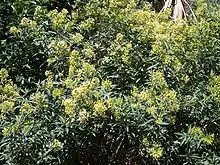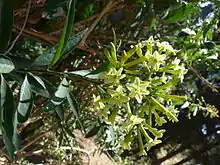Cestrum parqui
Cestrum parqui, commonly known as palqui, green cestrum or willow-leaved jessamine,[1] is a species of flowering plant native to Chile. In Australia the plant is regarded as a noxious invasive weed and a significant hazard to livestock (especially cattle) which may eat it inadvertently or during shortages of other foods, often resulting in death.
| Cestrum parqui | |
|---|---|
 | |
| Scientific classification | |
| Kingdom: | Plantae |
| Clade: | Tracheophytes |
| Clade: | Angiosperms |
| Clade: | Eudicots |
| Clade: | Asterids |
| Order: | Solanales |
| Family: | Solanaceae |
| Genus: | Cestrum |
| Species: | C. parqui |
| Binomial name | |
| Cestrum parqui | |
In cultivation in the United Kingdom this plant has gained the Royal Horticultural Society’s Award of Garden Merit.[1] (confirmed 2017).[2]
Description
C. parqui is a fast-growing, straggling, woody, deciduous or semi-evergreen shrub with one or more fragile green stems. The alternate, light green leaves have an unpleasant rubber-like smell when crushed. It produces terminal sprays of small, fragrant, tubular yellow-green flowers 2.5 cm long from late spring to autumn, followed by bunches of small, black, egg-shaped berries produced from summer to autumn. All parts of the plant are reported to be highly toxic.[3]
Reproduction
The small, black fruits of Cestrum parqui are highly attractive to birds, which play a major role in seed-dispersal, passing the seeds in their droppings: seedlings are thus often found growing under perching trees, along fencelines, and in creek banks, where it is also dispersed by water.[3]
Uses
Medicinal
The plant contains toxic alkaloids. It has been used in folk medicine to treat tumours and haemorrhoids and possesses sudorific (= perspiration-inducing), laxative and antispasmodic properties. Decoctions or infusions of the plant have also been administered in cases of intermittent fever and an infusion of the inner bark drunk to treat unspecified "stomach ailments". A poultice prepared from the plant (part unspecified) in combination with Solanum nigrum (part unspecified) and the crushed stems of Vitis vinifera, the grape vine, is believed in folk medicine to have anti-inflammatory properties.[4]
Ritualistic
Branches of Cestrum parqui are used to slap patients during shamanic healing ceremonies utilising the hallucinogenic plant Latua pubiflora held by the indigenous Huilliche people of the Los Lagos Region of southern Chile. This is done in the belief that the foul smell of the Cestrum leaves is abhorrent to the demons believed to be causing the patient's illness and will cause them to leave the patient's body in vomit.[5]
Gallery
 Specimen flowering in Royal Botanic Garden, Madrid.
Specimen flowering in Royal Botanic Garden, Madrid. Close-up of willow-like leaves and greenish flowers.
Close-up of willow-like leaves and greenish flowers.
See also
References
- "RHS Plantfinder - Cestrum parqui". Retrieved 12 January 2018.
- "AGM Plants - Ornamental" (PDF). Royal Horticultural Society. July 2017. p. 16. Retrieved 24 January 2018.
- "Weeds of Australia: Biosecurity Queensland Edition". Queensland Government. Retrieved 28 August 2018.
- Quattrocchi, Umberto (2012). CRC World dictionary of medicinal and poisonous plants: common names, scientific names, eponyms, synonyms and etymology, pub. CRC Press Taylor and Francis Group. Vol. II C-D, page 201.
- Plowman, Timothy, Gyllenhaal, Lars Olof and Lindgren, Jan Erik Latua pubiflora magic plant from southern Chile Botanical Museum Leaflets Harvard University Vol. 23, No. 2, Cambridge, Massachusetts, November 12, 1971.